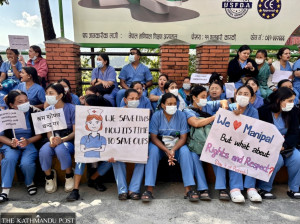Editorial
Ramp up spending
That govt hasn’t acted, despite knowing pitfalls of low capital expenditure, is embarrassing
The government’s capital spending is most likely to take place towards the final quarter in this fiscal year as well, as only 11 percent of the capital budget has been used in the first six months. The government allocated a budget of Rs312 billion for capital expenditure in the current fiscal year. But after six months, only Rs35 billion has been spent.
The government’s capital expenditure includes spending on civil works and purchase of land, building, furniture, vehicles, plants and machinery, among others. It is essential to spend funds allocated for these projects on time to bridge the infrastructure gap, which is a binding constraint for Nepal’s economic growth. Hence, the problem of low capital expenditure must be addressed if the government wants to attract private investment, raise people’s living standard and attain the overarching goal of shared prosperity.
Every incoming government has time and again claimed that it would introduce measures to increase capital spending. But the problem remains unresolved. Capital expenditure has always been bunched up towards the last quarter of the financial year, resulting in the construction of sub-standard infrastructure projects. This, in turn, tends to push up future recurrent expenditure, as more funds need to be earmarked to maintain unfit infrastructure.
Earlier, the blame for slow capital spending was placed on the delay in introducing and endorsing the budget. But this time the budget was presented in Parliament one-and-a-half months prior to the commencement of the financial year and endorsed before the beginning of the new fiscal year. Also, the Ministry of Finance extended spending authority to different ministries on the first day of the fiscal year.
Despite this, capital spending failed to pick up. This is a clear indication that the delay in capital spending is a structural problem in the country. This calls for the need to conduct proper studies before incorporating projects and programmes in the budget. Also, project management offices should be established on time, land required for the project should be acquired before projects are implemented, procurement plans should be prepared on time, and line ministries should be instructed not to delay the process of releasing funds.
The fact is the government is well aware of these pitfalls of slow capital spending. Yet it has not been able to resolve these problems till date, which is embarrassing to say the least.




 24.12°C Kathmandu
24.12°C Kathmandu














